Greetings from Rajasthan, the dynamic centre of India’s cultural tapestry! This travel blog will unveil the mysteries of this fascinating state and serve as your ticket to a rainbow of customs, hues, and friendliness. Rajasthan is enticed with tales of valour and wealth, from the stately palaces of Jaipur to the soul-stirring desert lullabies of Jaisalmer. Come along as we explore vibrant bazaars filled with exquisite handicrafts and indulge in the flavorful food that embodies the culture of Rajasthan. Set off on a voyage across culture where every step is a reflection of this regal land’s friendly customs, rich history, and enduring charm.

Exploring the Colourful Culture of Rajasthan
Set off on a journey across Rajasthan’s kaleidoscope delights, where every turn is decked with vivid colours and a wealth of cultural traditions. Delve into the heart of a place that resonates with history, customs, and an unrivalled zeal for life. Rajasthan is a blank canvas filled with the brushstrokes of regality and mythology, from the lavish palaces of Jaipur to the golden dunes of Jaisalmer. Traditional music echoes through busy marketplaces filled with elaborate handicrafts that reveal the tales of talented craftspeople. Savour the flavorful food of Rajasthan, a sensory extravaganza that reflects the hospitality of its people.
The History of Rajasthan

Explore the rich history of Rajasthan, a state that stands as a testimony to India’s regal past, on a thrilling trip through the sands of time. The word “Rajasthan” conjures up images of a bygone period, translating to “Land of Kings.” Its past is a tapestry stitched with strands of valour, richness, and cultural splendour spread across its majestic forts and palaces. The stately Amber Fort in Jaipur, the Pink City, is a symbol of Rajput strategic genius, while Jodhpur’s Mehrangarh Fort stands dramatically against the desert horizon, recounting tales of imperial splendour. The “Golden City” of Jaisalmer, with its elaborately carved havelis and the imposing Jaisalmer Fort, transports tourists to a time when trade and commerce were thriving.
The liveliness of Rajasthan’s bazaars, nestled within the labyrinthine lanes of its mediaeval cities, illustrates the convergence of many cultures and trade routes that have crisscrossed the country for generations. Rajasthan’s past is not limited to stone monuments; it can be heard in the throbbing beats of traditional celebrations. Holi’s kaleidoscope of colours and Diwali’s brilliant grandeur reflect the historical significance of both events, forging a connection between the present and the past.
Rajasthan’s architectural marvels reveal a combination of Rajput, Mughal, and Maratha influences. Udaipur’s lakeside palaces, such as the City Palace, exemplify the love sagas that transpired within its walls. Uncovering Rajasthan’s past is an immersive experience, an exploration of a state where every stone, festival, and ritual tells a tale, encouraging modern-day visitors to become a part of its eternal narrative.
Rajasthani Cuisine: An integral part of the Culture of Rajasthan
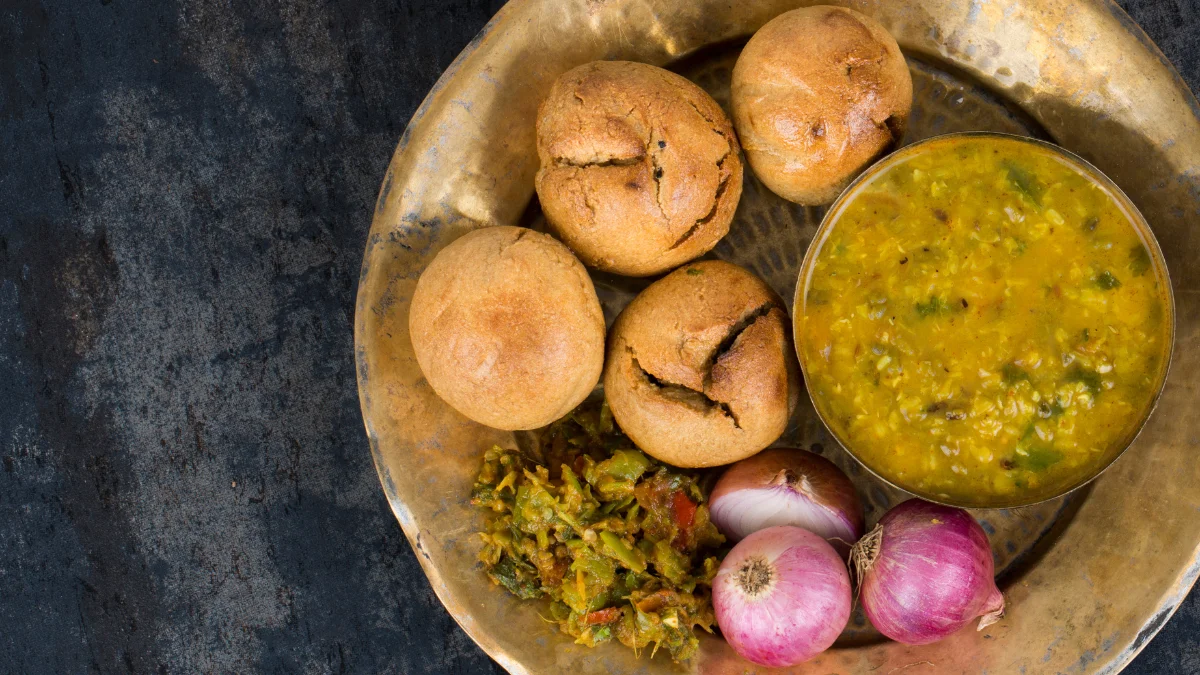
Take a gourmet tour across Rajasthan’s distinct flavours, where the food scene reflects the state’s rich cultural diversity. Travellers with a refined palate should definitely sample the variety of delicacies offered by Rajasthani cuisine, which is known for its abundance of spices and a distinct hint of sweetness.
The standout dish is the dalbati, a delicious combination of dal and wheat flour kneaded with yoghurt and topped with ghee. This delicious treat embodies the essence of traditional Rajasthani cuisine. Another delectable treat is kachori, which is available in two different flavours: the sweet mawa kachori and the fiery pyaaz, or onion kachori. These tasty delights are easily accessible at neighbourhood food stands all around Rajasthan, beckoning you to enjoy the many flavours of the area.
Satisfy your sweet craving with the delicious Ghewar and Gheriya, which are sweet desserts from Mewar that are commonly found in eateries around the state. Notably, ghee is a fundamental component of most Rajasthani cuisine, lending a unique depth of flavour to the meals.
Surprisingly, more than 70% of people in Rajasthan are vegetarians, and the majority of them are lacto-vegetarians. However, there are also outstanding non-vegetarian dishes like the delicious Lal Maas and Mohan Maas, which enhance the dining experience for people who prefer meat dishes. With its enticing combination of tradition and innovation, Rajasthan’s culinary legacy invites you to experience the spirit of this richly cultural state, mouthful after delicious morsel.
Rajasthani Folk: Music and Dance Forms of Rajasthan
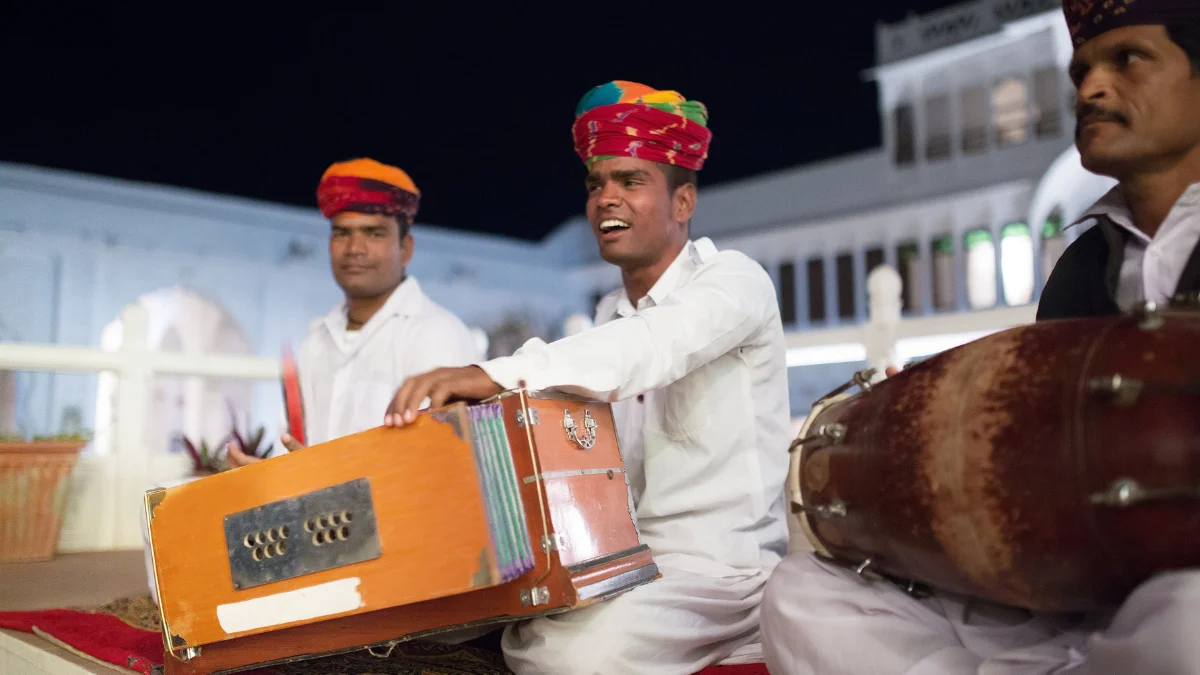
Set off on an enthralling journey through the colourful culture of Rajasthan, where the influences of numerous kings have weaved a rich and varied folk tradition. Different folk cultures have evolved throughout the area, each with its distinct marks from Rajasthan’s illustrious history. Influenced by regional differences, folk music and dance develop as engrossing segments of this cultural story.
An important part of Rajasthani folk music’s melodic symphony is the Manganiyars and Langas, who play ‘ragas’ for a variety of events. Their performances are filled with tradition; they tell stories of love and bravery and invoke the premonsoon showers. These musical odysseys are accompanied by traditional instruments like the sarangi, kamayach, dhols, shenhai, and been, which create a spell of cultural resonance.
Various dance genres like as chang, ghoomer, bhopa, tejali, and kathipuli highlight the dynamic emotions of various tribes. Born in Udaipur, the internationally recognised Ghoomer dance is proof of Rajasthan’s cultural powerhouse’s global appeal.
This all-encompassing exploration of the culture of Rajasthan reveals a dynamic landscape where the past and present mingle to produce a symphony of customs, folktales, and creative expressions that characterise this magnificent region.
The Importance of Camels in Rajasthan
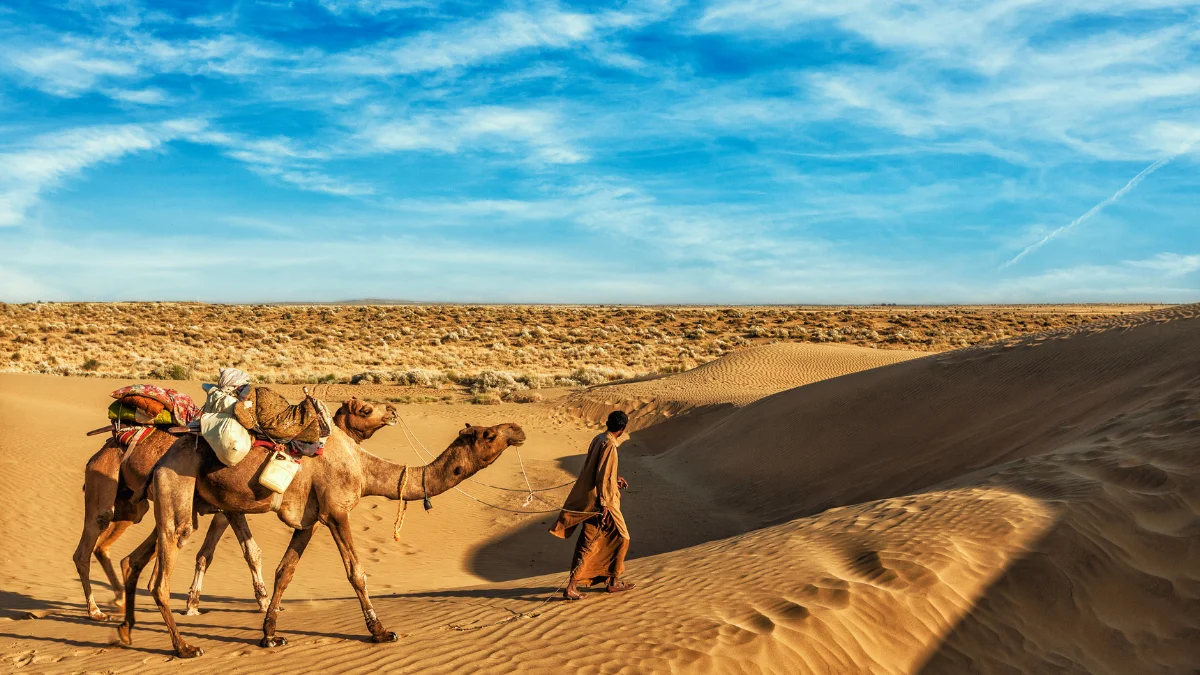
Take in the fascinating culture of Rajasthan, where camels are revered as the primary representations of the desert. These hardy animals, which are well suited to withstand the difficulties of scarce water supplies, high temperatures, and constant wind, are an essential component of the culture. Camel rides in Rajasthan are more than simply pastimes; they’re immersive experiences that provide a close-up look at the amazing capacity of these creatures to move across the dry, barren landscapes with their long hooves.
The Camel Fairs are a yearly event that takes place in Pushkar, Bikaner, and other nearby areas. These festivals are more than just get-togethers; they are devoted commemorations honouring the “ship of the desert” and its committed proprietors. Over two days, a variety of activities and events are held to highlight the friendship between humans and camels. Experience exhilarating camel races, where these magnificent animals demonstrate their agility, and marvel at captivating camel dance performances that infuse the cultural feast with a rhythmic flair. Rajasthan’s Camel Fairs are more than simply festivals; they are colourful representations of the close relationship that exists between the inhabitants of the desert and their faithful companions.
Handicrafts of Rajasthan
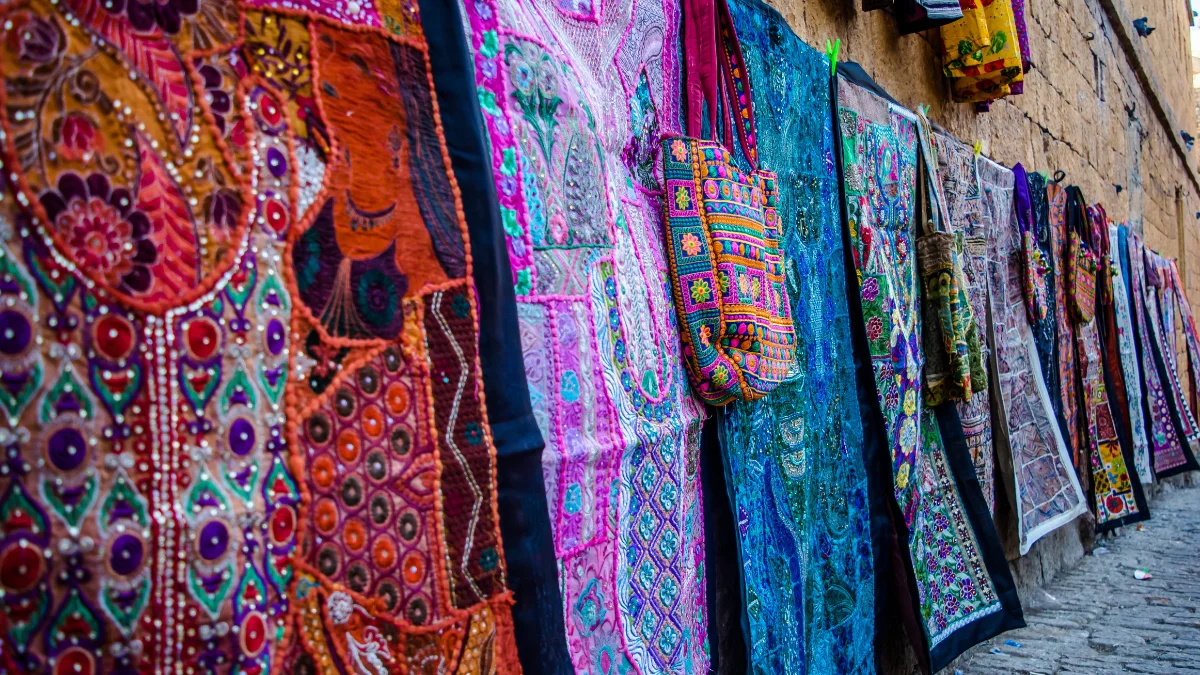
Take a sensory tour of Rajasthan’s colourful handicrafts, which are the result of the union of expert artisans and centuries-old traditions, producing a kaleidoscope of hues and textures. Rajasthan’s creative past is as varied as its terrain, making it a treasure trove of artistry that provides an enthralling look into the state’s rich cultural tapestry.
The vibrant marketplaces of Jaipur, Jodhpur, and Udaipur are true gold mines, displaying a wide variety of handicrafts that are a testament to the artistic talent of the area. The traditional art style of block printing, which embellishes fabrics with beautiful designs, is highly praised in Rajasthan. Sanganer is especially well-known for its vivid block-printed textiles, which are created by skilled artisans who painstakingly cut wooden blocks to stamp elaborate designs on cotton and silk. The spirit of Rajasthan’s artistic vitality is captured in these textiles, also called Sanganeri designs, which are then fashioned into gorgeous clothing, bedspreads, and accessories.
Another jewel in Rajasthan’s handicraft crown is its traditional jewellery, painstakingly made by generations of artisans. Because of its long history with gemstones, Jaipur is a major centre for the jewellery-making industry. Beautiful items made by enamelling vivid colours and meticulously setting precious stones in gold are known as kundan and meenakari pieces. The end product is a sumptuous collection of jewellery that features enamel work bangles, Polki earrings, and the well-known Kundan necklaces. These items continue the tradition of royal adornments while also demonstrating Rajasthani artistry.
Rajasthan has a rich history of handicrafts that goes beyond jewellery and textiles. The state is known for its stunning blue pottery, which is a unique art form. With Persian and Chinese inspirations, Jaipur’s Blue Pottery is a wonder of handiwork. Artists use clay to sculpt and glaze delicate designs, then coat them in cobalt oxide to produce distinctive azure hues. Intricately designed plates, bowls, and ornamental objects are not only useful but also beautiful works of art that capture Rajasthan’s rich cultural heritage.
Discovering Rajasthan’s bright handicrafts is like discovering a live culture in the hands of talented artists rather than merely looking at artefacts. Every item of art, whether it is a complex jewellery piece or a hand-printed cloth, conveys a tale of love, legacy, and the everlasting spirit of artistic expression in this culturally diverse state.
Famous Tourist Attractions Showcasing the Culture of Rajasthan
Through prominent tourist destinations that are testaments to the rich culture of Rajasthan, a fabric of regal past and lively customs reveals its cultural splendour.
Jaipur
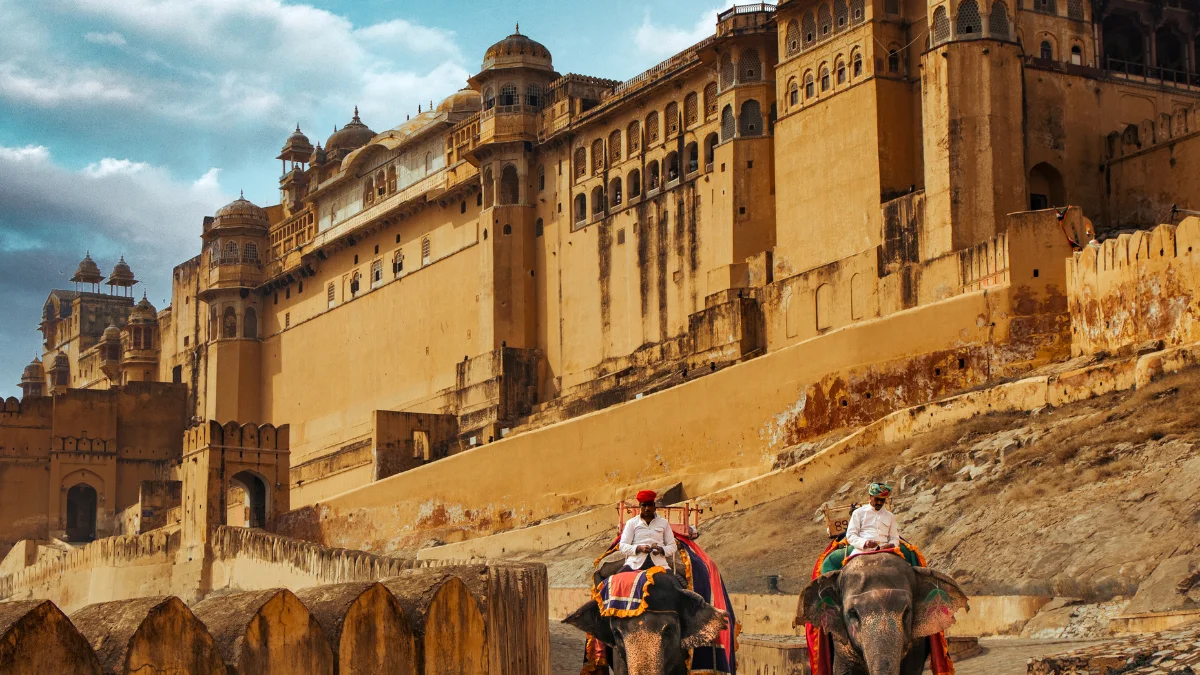
The magnificent Amber Fort in Jaipur, which is recognised as a UNESCO World Heritage site, captures the regal essence of the area beyond only architecture. Blending in perfectly with the cultural story that characterises the state, this strong castle, with its elaborate marble carvings and imposing ramparts, provides a look into the rich lifestyle of Rajasthan’s former kings.
Jaisalmer
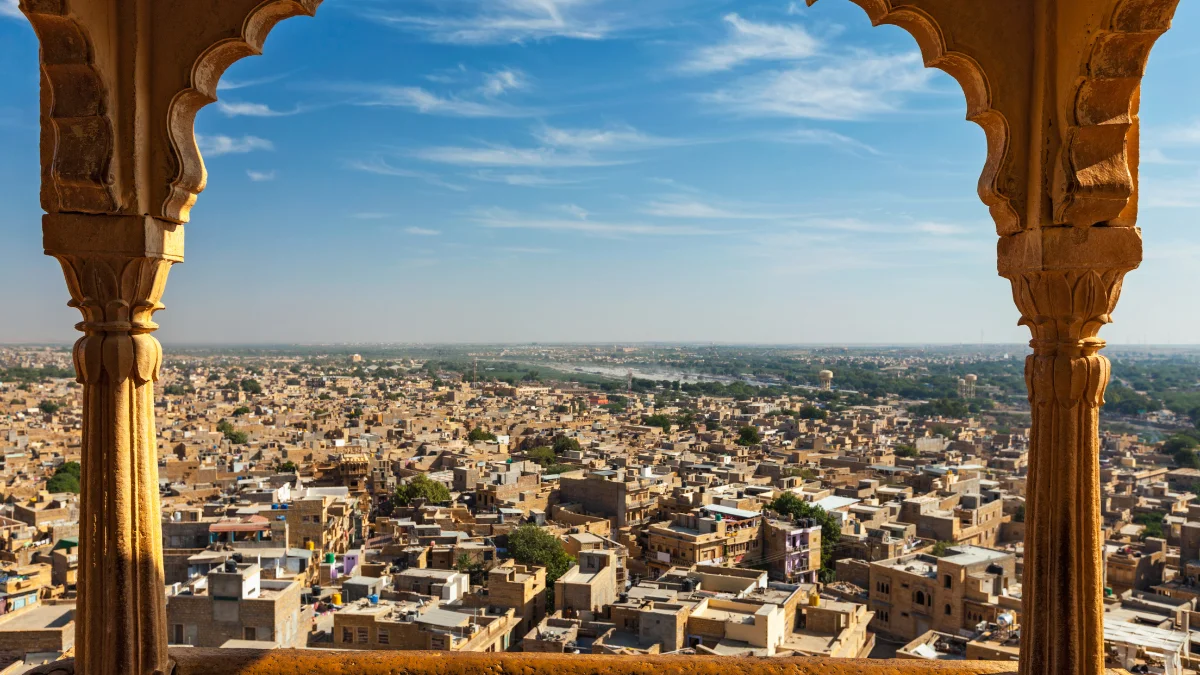
With its magnificent Jaisalmer Fort, an architectural marvel that reflects the cultural magnificence of Rajasthan, Jaisalmer, also known as the “Golden City,” beckons. Within its gates lie lively marketplaces, beautiful Havelis, and temples; this living fort is a hive of activity. The finely carved sandstone facades take tourists into the centre of Rajasthan’s cultural heritage while whispering tales of bravery and trade.
Udaipur
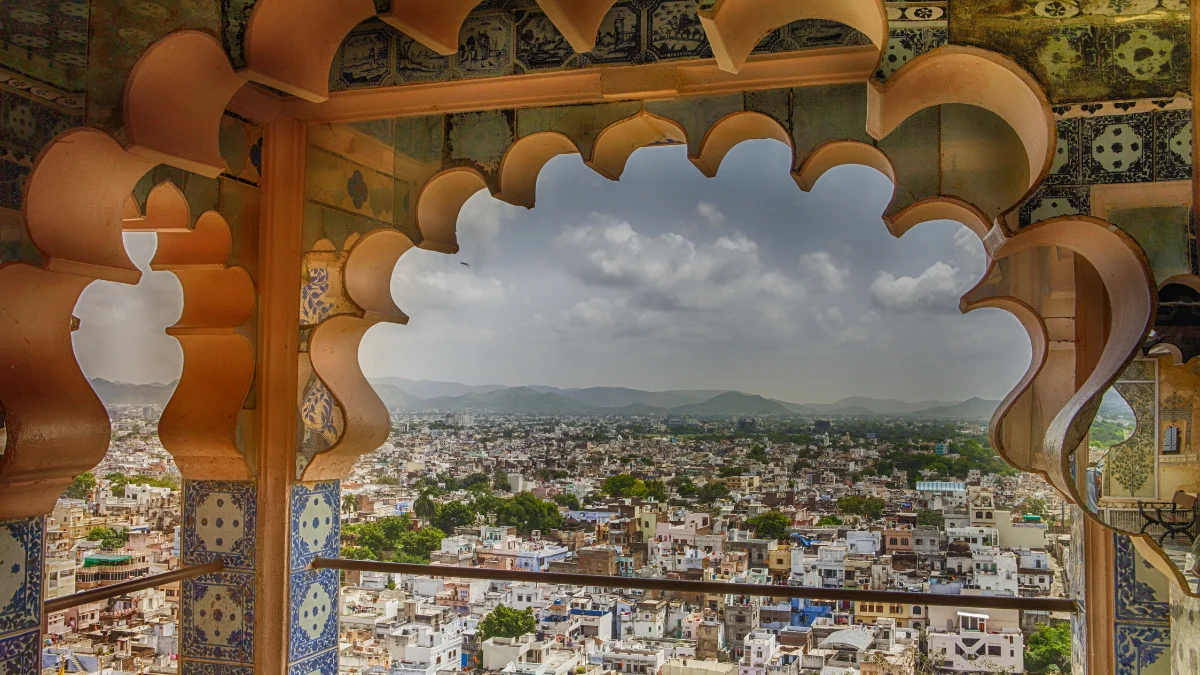
A visit to Udaipur, the “City of Lakes,” where the City Palace stands as a testament to creative genius, is an essential part of any investigation into Rajasthan’s cultural environment. Situated on Lake Pichola, this palace complex showcases the cultural syncretism that characterises the state with its harmonious combination of Mughal and Rajput architectural traditions. Visitors are submerged in the cultural extravagance of Rajasthan through the lavish gardens, elaborate balconies, and mirrored halls, which all represent the imperial grace that has persisted over the ages.
Preserving and Promoting the Culture of Rajasthan
In order to ensure that the vivid tapestry of the culture of Rajasthan continues to be an enduring legacy for future generations, it is crucial to preserve and promote the state’s rich cultural history. Work is carefully focused on preserving the state’s cultural treasures, which include its magnificent forts, sumptuous palaces, and traditional arts. These architectural wonders—like Jaipur’s Amber Fort and Jaisalmer Fort—serve as both visual extravaganzas and cultural custodians, telling tales of bravery and imperial grandeur.
Traditional arts and crafts that characterise the core of the culture of Rajasthan are included in cultural preservation programmes, which go beyond architectural gems. The objective of government-backed initiatives and community-based campaigns is to enable regional craftspeople to guarantee the survival of artistic endeavours such as elaborate jewellery design, block printing, and ceramics. Rajasthan’s cultural legacy not only survives but also captivates the globe with its authenticity and creativity thanks to the fostering and promotion of these age-old crafts.
The goal of promoting pride and awareness of Rajasthani citizens is at the core of this cultural revival. The multifarious culture of Rajasthan is celebrated via cultural festivals and events like the grandiose Jaipur Literature Festival and the colourful Pushkar Camel Fair. In addition to showcasing the state’s rich cultural heritage to a worldwide audience, these initiatives also foster in the populace a feeling of gratitude and accountability, ensuring that the culture of Rajasthan endures as a resilient and dynamic living legacy.
Conclusion
Every fort, every dance, and every craft in the captivating tapestry of the culture of Rajasthan narrates a tale of fortitude and authority. Preserving this cultural legacy is an invitation to discover the enduring charm of a state that wears its past with pride, not just a responsibility. Rajasthan invites you with wide arms, urging you to immerse yourself in its live traditions as we visit its vibrant streets, breathtaking palaces, and busy bazaars. Take a trip where the past and present dance together and leave lasting impressions on your heart, guided by the echoes of history and the vibrant arts of the region. Welcome to Rajasthan, the land of eternal culture.


